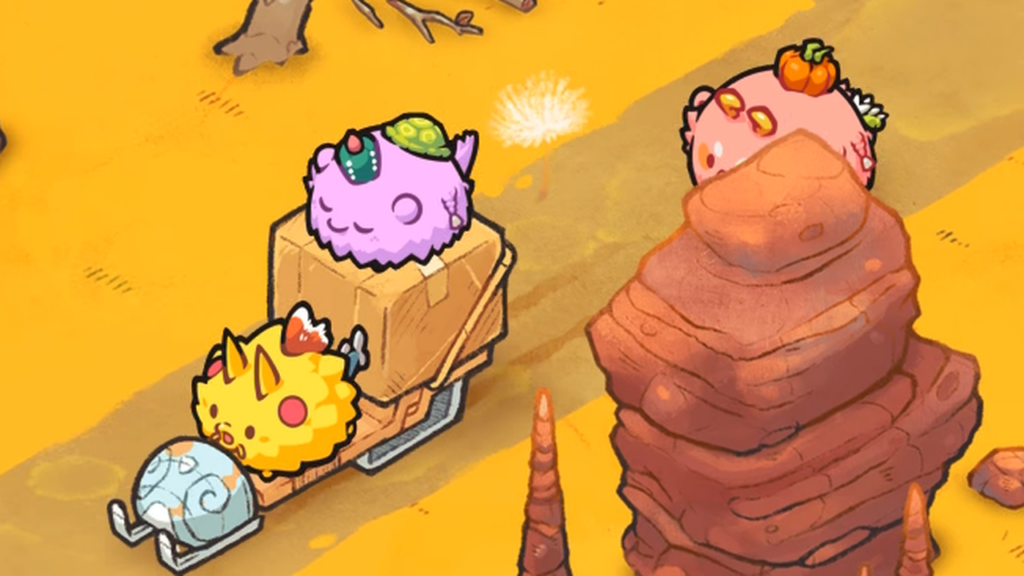ERC-20 governance token AXS (Axie Infinity Shard). That is, an Ethereum smart contract token designed to function similarly to stock, with owners receiving ‘dividends’ and the ability to vote on major game and economic problems using their tokens. AXS is traded on multiple exchanges, including Binance, and is based on the Ronin blockchain (an Ethereum Network sidechain).
Like other ERC-20 tokens, there is a limit on how many may be generated. In this case, 270 million dollars will be distributed in phases and in varying quantities to different parties and for diverse objectives. The whitepaper clearly defines the allotment, with slightly over 22% now in circulation.
Staking, which involves locking coins in exchange for a share of the Community Treasury, provides the ‘dividend’ part (AXS and wETH). The axie infinity marketplace charges a 4.25 percent fee (aka tax), which means that each deal sends 4.25 percent of the total wETH value (which the seller loses) to the Community Treasury. Similarly, all AXS that have been sunk in breeding have been relocated here.
The Community Treasury now possesses roughly 35k wETH (worth $100 million USD) and 18 million AXS (worth $1.18 billion USD). With a total current circulation of over 60 million AXS, the Treasury controls around 30% of all AXS. We also arrive at a value of $1.67 USD per AXS based on a base value of wETH treasury value (USD) / AXS circulation cap. However, at roughly $70 USD, AXS is now selling at nearly 40 times that value.
The tokens will also be used to enable governance voting on particular game concerns. The kind of topics that may be voted on seem to be shifting from Treasury distribution to complete separation from Sky Mavis in 2023. As the game “gradually grows into a community-owned Decentralized Organization,” the whitepaper advocates transferring to a DAO (Decentralised Autonomous Organisation).
As of this writing, staking has just recently been enabled (30 September). However, despite being scheduled to be online by the end of the first half of this year, governance votes remain now inactive. As a result, AXS now solely serves as a breeding token rather than a governance token. Sky Mavis may also change their mind about using AXS since they are not legally bound by their intentions.
While several games currently let users to vote on feature development (see Old School Runescape’s polls), Axie Infinity ‘s whitepaper proposes radical power seeding of a game, which is mostly unknown terrain. While AXS promises to assist match player interests with a game’s economic goals, it is feasible that populism within the player base or the voting power of rich parties might potentially impair the game’s performance. So it’s unclear how much genuine governance Sky Mavis will provide AXS holders.

Breeding and the Market
As an NFT, all axes reside on the Ronin blockchain. As a result, breeding is the process of creating a new axie NFT. To start the breed, the player must spend both SLP and AXS, with the quantity of SLP depending on the parent axies’ breed count. With a limit of seven breeds per axie, each breed raises the SLP cost of following breeds. The present cost of breeding two virgin axes is 300 SLP and 1 AXS, although Sky Mavis constantly changes pricing in order to keep the economy balanced.
The freshly bred axie is created via a genetic process similar to that used in CryptoKitties, in which the kid axie inherits the parent axie’s traits. As a result, type and body parts are determined by the parents.
Axies may then be sold for wETH on the Axie Infinity Marketplace (Etherum token).
Is Axie Infinity a long-term investment?
Pegaxy, a blockchain-based horse racing game, has grown in popularity since its introduction last October, with hundreds of thousands of participants and millions of dollars streaming into its network each week. In the game, participants compete against one another by racing non-fungible tokens (NFTs) of horses, which have unique digital signatures on the blockchain and may sell for up to $100,000. However, Pegaxy’s Hanoi-based team did not model the game on the Kentucky Derby or the Preakness Stakes. Instead, the creators wanted to cash in on the success of another Vietnamese startup, Sky Mavis, which had created a Pokemon-like fighting game and sparked a blockchain gaming craze that is expected to be worth $40 billion by 2025.

Axie Infinity, Sky Mavis’ game, has attracted notable investors such as Mark Cuban and Andreessen Horowitz to the industry. pegaxy has copied Axie’s play-to-earn concept, which enables players to exchange in-game victories for real money, a feature that has enabled Axie Infinity become a full-time job for hundreds of thousands of people in the Philippines and worldwide in the last year. However, Axie’s creators recently realized that the play-to-earn paradigm that fueled the platform’s ascent was unsustainable, and they released an upgrade intended at completely revamping the game’s economy.
The corporation is now attempting to attract gamers who want to play for enjoyment rather than for profit. Pegaxy is refusing to join the pivot. Instead, the horse racing industry is forging on its own, virtually doubling down on the play-to-earn strategy pioneered by Axie Infinity and then abandoned. The divergent perspectives of the two games reflect a broader discussion about how firms will utilize blockchain—the technology presently used to race digital ponies and combat digital monsters—to determine the future of how the world plays, works, and does business.
In conclusion
The coming together of the crypto world and online gaming in the shape of Axie Infinity signals a significant transition, not just in the future of online gaming but also in the rising relevance of digital ownership. This is many people’s first encounter with blockchain-based games or activities. While there are still significant issues and unknowns around blockchain-based experiences, the fact that such a project exists is remarkable, and it is likely to influence future trends. It will be intriguing to see what the future holds for Axie Infinity, whether it be the development of land-based games on Lunacia or the ongoing breeding of unique Axies.
